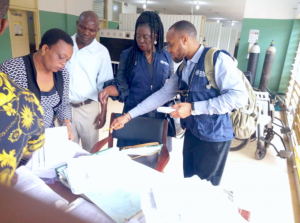WHO supports five countries to fight Lassa fever outbreaks
Brazzaville, 8 February 2019 – With five countries in Western Africa reporting outbreaks of Lassa fever, the World Health Organization (WHO) has scaled up its efforts to support the region’s response to the disease.
While these outbreaks are occurring during the Lassa fever season in countries where the disease is endemic, the speed of escalation is of concern.
The largest outbreak thus far has affected 16 states in Nigeria. The Nigeria Centre for Disease Control (NCDC) declared an outbreak of Lassa fever on 22 January 2019. The 213 confirmed cases to date, including 42 deaths, mark a significant increase – already a third of the total cases for all of last year, when Nigeria experienced its worst outbreak of Lassa fever. Four health workers have been infected so far in this latest outbreak.
In Nigeria, WHO is scaling up its efforts to support the Federal authorities, NCDC and the affected Nigerian states in responding to the outbreak. An important focus is on early detection and confirmation of suspected cases, providing optimal supportive care and ensuring infection prevention and control measures in designated health care facilities in the affected states. WHO has intensified its technical assistance and is supporting coordination, enhanced surveillance, epidemiological analysis and risk communication. WHO is also mobilizing experts to support case management and infection prevention and control.
A total of 12 cases have been confirmed to date in Benin, Guinea, Liberia and Togo, including two deaths, with more suspected cases being investigated. WHO is assisting health authorities in these countries with contact tracing and providing medical and non-medical supplies and technical and financial resources as needed for case management, risk communication and logistics.
“We are concerned by the high number of cases so early in the Lassa fever season, which is expected to last another four more months,” said Dr Ibrahima Socé Fall, Regional Emergencies Director at WHO Regional Office for Africa. “WHO is working with the health authorities in the five-affected countries to ensure health workers have the capacity to detect cases and we are monitoring the regional spread of the disease.”
WHO has set up a regional coordination mechanism for countries to report any suspected case of Lassa fever to expedite the flow of timely information and to assess the situation, recommend actions and help organize assistance. WHO has also reached out to the six other at-risk countries – Burkina Faso, Cameroon, Ghana, Mali, Niger and Sierra Leone – and is supporting prevention and readiness activities as needed.
“WHO continues to advise all countries in the Lassa fever belt to enhance their preparedness and response capacities, especially for early case detection, laboratory confirmation, case management under recommended barrier nursing, risk communication and community engagement,” said Dr Fall.
Lassa fever is an acute viral haemorrhagic illness that occurs predominantly in West Africa, after human exposure to the urine or faeces of infected Mastomys rats. More than 80% of Lassa fever cases are rodent-to-human transmission. Person-to-person transmission occurs in both community and health-care settings.
Prevention of Lassa fever relies on promoting good “community hygiene” to discourage rodents from entering homes by storing grain and other foodstuffs in rodent-proof containers, disposing of garbage far from the home, maintaining clean households, keeping cats and the safe handling of anyone who may have died of the disease. In health-care settings, health-care workers should always apply standard infection prevention and control precautions when caring for patients.
Communications Manager
WHO Regional Office for Africa
Email: okas [at] who.int (okas[at]who[dot]int)
Tel: +242 06 508 1009
Communications and marketing officer
Tel: + 242 06 520 65 65 (WhatsApp)
Email: boakyeagyemangc [at] who.int (boakyeagyemangc[at]who[dot]int)




